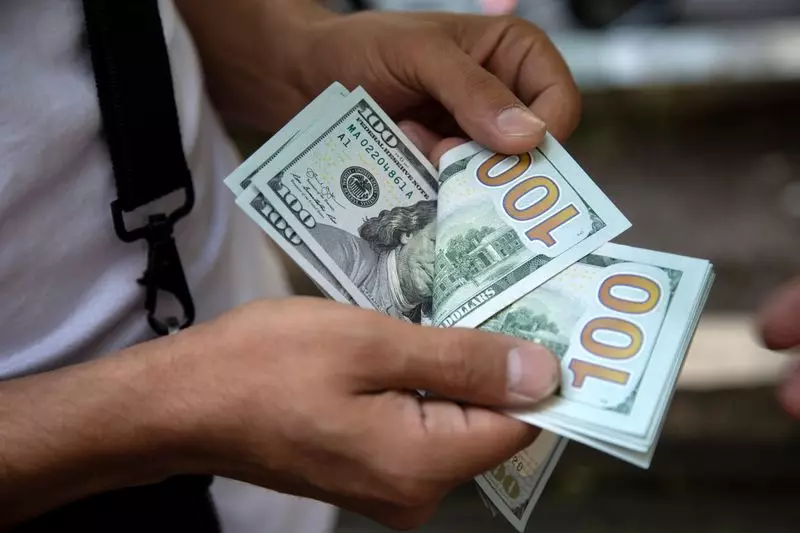As the economic landscape evolves, the U.S. dollar has witnessed a notable uptick in value, a trend observed consistently throughout October. Markets are now looking ahead at the impending release of the highly anticipated payroll report, which could significantly affect future currency movements and monetary policy. Here, we explore key economic indicators influencing the dollar’s strength, the forecasts for employment figures, and the broader implications for both domestic and international financial markets.
On the cusp of the jobs report, the Dollar Index, a benchmark that evaluates the U.S. dollar against a selection of six other major currencies, rose by 0.1% to 104.025. This increase follows an impressive surge of over 2% in the previous month, highlighting a growing confidence among investors in the strength of the dollar. A critical driver of this bullish sentiment can be traced back to recent inflation data. The personal consumption expenditures (PCE) index, a key measure of consumer price changes preferred by the Federal Reserve, revealed a year-over-year inflation rate of 2.1% for September. This figure indicates a slight decrease from 2.3% in August, suggesting that inflation is aligning closely with the Fed’s target of 2.0%.
In the context of these figures, market analysts are keenly awaiting the October nonfarm payrolls report. Predictions hint at a decline in job growth, with expectations of only 106,000 new jobs added compared to a more robust 254,000 in the previous month. Such a downturn could influence the Federal Reserve’s forthcoming policy decisions, reinforcing speculation around potential interest rate cuts.
Market analysts are widely anticipating a quarter percentage point reduction in interest rates from the Federal Reserve in the upcoming week. Current futures contracts suggest there is a 94.7% probability of this cut occurring. However, the actual payroll figures released later today might sufficiently impact market expectations, particularly if the numbers deviate substantially from projections. Analysts believe any unfavorable employment data could potentially erode some of the dollar’s recent gains, as traders recalibrate their expectations for future rate adjustments.
In an analysis note from ING, the possibility of a negative immediate reaction for the dollar was underscored, noting that some strength from previous jobs reports may no longer be part of the current market pricing. With heightened speculation surrounding rate cuts later in the year, many traders are also closely monitoring the performance of labor markets as a salient factor influencing the dollar’s trajectory.
In addition to economic indicators, the geopolitical climate surrounding the upcoming presidential election on Tuesday adds another layer of complexity to market dynamics. Current market sentiments appear to favor Republican candidate Donald Trump, and should there be a significant shift in political leadership, trading activity could be heavily impacted, particularly if Vice President Kamala Harris secures a victory. This uncertainty may lead to increased volatility and general market unwinding, which could further affect currency valuations, especially for the dollar.
Taking a closer look at currency pairings, EUR/USD has dipped by 0.2% to 1.0861, retracing some gains from previous sessions as market participants digest mixed signals regarding the eurozone. Specifically, inflation data, which came in higher than expected for October, complicates the European Central Bank’s (ECB) potential for future rate cuts. With the ECB having already reduced rates three times this year, further adjustments are anticipated as the year nears conclusion.
The ongoing adjustments in various currencies also reflect broader economic themes seen across international markets. For instance, GBP/USD experienced a minor increase, yet analysts at ING predict further depreciation could result from the recent UK budget announcement, with significant tax increases from British finance minister Rachel Reeves looming. The dynamics unfolding in the currency pairing suggest an environment where rate differentials could support the dollar’s value.
Finally, the USD/JPY pairing appears to be tracking upward, currently resting at 152.72. The Bank of Japan’s decision to maintain ultra-low interest rates impacted the yen negatively as recent remarks indicated fewer dovish tendencies than before. The interplay between domestic Japanese economic policies and U.S. economic conditions adds complexity to understanding the directionality of these exchanges.
As we edge closer to the release of the October jobs report, all eyes are on both the domestic exchanges in the U.S. and the broader implications for global markets. Investors must navigate the evolving landscape that intertwines economic indicators, government policy projections, and geopolitical uncertainties. The outcomes of these elements will largely dictate the U.S. dollar’s trajectory and will certainly play a pivotal role in shaping market sentiment in the weeks to come.

